RBSE Solutions for Class 6 Science Chapter 2 Nutrition in Plants are part of RBSE Solutions for Class 6 Science. Here we have given Rajasthan Board RBSE Class 6 Science Chapter 2 Nutrition in Plants.
| Board | RBSE |
| Textbook | SIERT, Rajasthan |
| Class | Class 6 |
| Subject | Science |
| Chapter | Chapter 2 |
| Chapter Name | Nutrition in Plants |
| Number of Questions Solved | 52 |
| Category | RBSE Solutions |
Rajasthan Board RBSE Class 6 Science Chapter 2 Nutrition in Plants
Intext Questions
Question 1.
Why do organisms need food? (Page 11)
Answer:
Organisms need food for :
- The growth and development of their body.
- The repair and maintenance ofthe damaged parts of the body.
- Various activities that take place in their body.
Question 2.
Can you tell how many types of plants are there on the basis of nutrition? (Page 12)
Answer:
On the basis of nutrition, plants are of following five types :
- Autotrophs
- Parasite
- Insectivorous
- Saprotrophs
- Symbiotic
Question 3.
How does the synthesis of food take place in autotrophic planats? (Page 12)
Answer:
The chlorophyll containing cells of plants, in the presence of sunlight use water, minerals and carbon- dioxide to synthesize their own food.
Question 4.
How do water and minerals absorbed by the roots reach the leaves ? (Page 13)
Answer:
The stem contains tube-like vessels through which water and minerals are transported to the leaves.
Question 5.
Does the process of photosynthesis and production of starch occur even in the absence of sunlight? (Page 13)
Answer:
No, the process of photosynthesis and production of starch does not occur in the absence of sun light.
Question 6.
There are some plants which do not have chlorophyll. They cannot synthesize their own food. Whom do they depend on for their food? (Page 14)
Answer:
Such plants take food from other plants or they obtain food from dead and decaying matter.
Question 7.
Have you ever heard about plants that, in order to survive, obtain their food from insects? (Page 14)
Answer:
Yes, pitcher plant and drosera are the plants that trap insects and digest them.
Question 8.
In nature, there are some plants which can eat insects to survive. What type of plants are these, name them. (Page 14)
Answer:.
They are called insectivorous plants.
For example – drosera, dionaea, urticularia, pitcher plant etc.
Question 9.
Carefully look at the following figure. It is a pitcher plant. (Page 15)
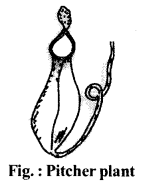
1. The pitcher – like structure is the modification of w hich part ?
2. What do you see above the pitcher?
Answer:
- The leaves are modified into pitcher.
- The apex of the leaf forms a lid above the pitcher.
Question 10.
Have you ever imagined why these (insectivorous) plants need insects as their food? (Page 15)
Answer:
These plants are found in swampy areas where the amount of nitrogen is insufficient. They eat insects to fulfil their nitrogen requirement.
Question 11.
During rainy season, you might have seen umbrella – like or white thread like structures on the dung, pickles, vegetables, wood and other decaying matter. What do you call them in your language ? (Page 16)
Answer:
We call them ‘fafundi’.
Question 12.
If they (saprotrophs) do not prepare their ow n food, then where do they get their food from? (Page 16)
Answer:
They get food from the dead and decaying matter.
Question 13.
You might have seen people involved in various professions and helping each other. Like doctor, engineer, lawyer, teacher, farmer, stockman, milk seller etc. Can anyone of these imagine to live without the help of people related to other professions? (Page 16)
Answer:
No, none of them can imagine to live like that. Actually, we can live a normal life only by mutual cooperation.
Question 14.
Do such cooperation and coordination exist in plants also? (Page 16)
Answer:
Yes, such cooperation and coordination exists in plants also. These plants are called symbiotic plants, e.g., lichen.
Activity
These plants are called symbiotic plants: (Page 13)
- Take two potted plants of the same genus.
- Keep one in the dark for 72 hours and the other in the sunlight.
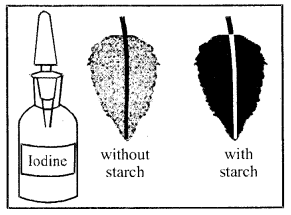
- Take one leaf from both the pots.
- Now place both the leaves in a test tube and dip them in spirit.
- Now keep the test tube in a beaker half filled with water, and boil it till the leaves lose all chrophyll molecules.
- Wash the leaves with water and perform iodine test on them.
Question 1.
Do you find any colour change in both the leaves?
Answer:
Yes, we see that the colour, change occurs in the leaf of the plant kept in sunlight, but no colour change occurs in the leaf of the plant kept in dark.
Question 2.
Why is there no change in colour of the leaf kept in dark?
Answer:
Photosynthesis takes place in the presence of the sunlight. Due to which, starch is made in the leaves of the plant kept in sunlight and so the leaf turns blue – black in colour when iodine solution is dropped on it. Photosynthesis does not occur in the plant which was kept in the dark. Thus, starch is not present in its leaves. Hence, there is no colour change in its leaf. Starch reacts with iodine and imparts blue-black colour. This is called starch test.
Exercises
Choose the correct option
Question 1.
It is a saprotrophic plant
(a) neem
(b) drosera
(c) mucor
(d) cuscuta
Answer:
(c) mucor
Question 2.
Those plants who depend on other plants for their food are called
(a) parasite
(b) autotroph
(c) saprotroph
(d) insectivorous plant
Answer:
(a) parasite
Question 3.
Which of the following is not an insectivorous plant?
(a) drosera
(b) dionaea
(c) cuscuta
(d) utricularia
Answer:
(c) cuscuta
Fill in the blanks
1. In lichen ……………. and ……………. live together.
2. In pitcher plant, pitcher is the modified form of …………..
3. The mode of taking essential nutrients in the form of food by an organism for its health and physical growth is called ………..
Answer:
1. fungi, algae
2. leaves
3. nutrition
Short Answer Type Questions
Question 1.
What is photosynthesis?
Answer:
The chlorophyll containing cells of plants, in the presence of sunlight use water, minerals and carbon dioxide to synthesize their own food. This process is called photosynthesis.
Question 2.
What is symbiosis?
Answer:
Some organisms live together and share food, water, nutrients and shelter. This mode of living is called symbiosis.
Question 3.
What is the difference between the host and the parasite?
Answer:
Plants who obtain their food from other trees or plants are called parasite whereas the tree or the plant from which the parasite obtains food is called the host.
Long Answer Type Questions
Question 1.
Describe insectivorous plants with suitable example.
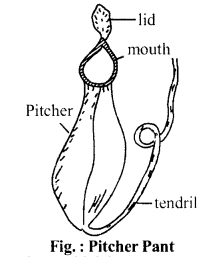
Answer:
Those plants which in order to survive, trap insects and digest them are called insectivorous plants, e.g., drosera, dionaea, utricularia, pitcher plant. In pitcher plant, the leaf is modified to form a pitcher-like structure. The bright colour of the pitcher makes it attractive. The apex of the leaf forms a lid. Inside the pitcher, there are hairs which are directed downward. The mouth of the pitcher is sticky. When an insect lands in the pitcer, it slips and gets entangled into the hair present into the neck of the pitcher. As the hair are directed downwards, the insects are unable to escape out. The insect is digested by the digestive juices secreted in the pitcher.
Question 2.
Write short notes on the following:
1. Symbiotic plants
2. Saprotrophic plants
3. Parasitic plants
4. Photosynthesis Science
Answer:
- Symbiotic plant – Some organisms live together and share food, water, nutrients and shelter. This mode of living is called symbiosis and the plants living together are called symbiotic plants e.g., lichen.
- Saprotrophic plants – The plants which take nutrients from the dead and decaying matter are called saprotrophic plants. These plants secrete digestive juices on the surface of dead and decaying matter. The digestive juices convert it into a solution which is absorbed by them to get nutrients.
- Parasitic plants – Plants which do not have chlorophyll and cannot synthesize their own food and obtain their food from other trees or plants are called parasitic plants. The plants which takes food from other plant is called parasite whereas the tree or the plant from which the parasite obtains food is called the host, e.g., Cuscuta
- Photosynthesis – The chlorophyll containing cells of plants in the presence of sunlight use water, minerals and carbon – dioxide to synthesize their own food. This process is called photosynthesis.
Practical Work
Question 1.
Collect the leaves of different plants found in your locality and prepare a scrap book.
Note: Students should collect different type of leaves and paste them in the scrap book.
Question 2.
Visit a greenhouse present in your locality. Look, how plants are grown there ? Find out how light, water and carbon – dioxide are regulated there for healthy growth of the plants.
Answer:
A green house is a structure with walls and roof made of glass. In a greenhouse, plants that require regulated climate conditions are grown. Greenhouses allow greater control over the growing environment of plants. Various factors such as temperature, levels of light, shade, irrigation and humidity can be controlled in a green house.
Other Important Questions
Multiple Choice Questions
Question 1.
Food is essential for the living beings for
(a) growth
(b) development
(c) repairing of damaged parts
(d) all of these
Answer:
(d) all of these
Question 2.
An example of macro nutrient is
(a) Zinc
(b) Boron
(c) Nitrogen
(d) Chlorine
Answer:
(c) Nitrogen
Question 3.
An example of micro nutrient is
(a) Nitrogen
(b) Copper
(c) Potassium
(d) Sulphur
Answer:
(b) Copper
Question 4.
Primary macro nutrient is
(a) Nitrogen
(b) Calcium
(cj Nickel
(d) Sulphur
Answer:
(a) Nitrogen
Question 5.
Lichen is an example of
(a) Parasite
(b) Saprotroph
(c) Symbiotic
(d) Insectivorous
Answer:
(c) Symbiotic
Fill in the blanks
1. Plants are the source of…………….. for all living beings.
2. ………………. are those nutrients which are required by plants in large amount.
3. The deficiency of any of the nutrient causes ……………… in plants.
4. The synthesis of food in plants occurs in the ……………
Answer:
1. food
2. Macro nutrients
3. diseases
4. leaves
Very Short Answer Type Questions
Question 1.
How much macro nutrients are required by plant
Answer:
From 0.2% to 4%.
Question 2.
Write the names of two micro nutrients.
Answer:
Zinc, Manganese.
Question 3.
What is stomata?
Answer:
The tiny pores present on the surface of the leaves are called stomata.
Question 4.
What is the function of stomata in leaves?
Answer:
Stomata help in exchange of gases.
Question 5.
Why is the colour of leaves green?
Ans.
Leaves are green in colour due to the presence of chlorophyll.
Question 6.
In which form, carbohydrates are stored in plants?
Answer:
Carbohydrates are stored in the form of starch.
Question 7.
Where are insectivorous plants found?
Answer:
These plants are found in swampy areas where the amount of nitrogen is insufficient.
Question 8.
What is fafundi called in scientific language?
Answer:
It is called fungimb
Short Answer Type Questions
Question 1.
How do plants obtain nutrients? Explain.
Answer:
Plants absorb nutrients and water through their roots but photosynthesis takes place in the leaves. Thus, plants get fluids and nutrients from the ground through their stems to their different parts that are above ground level.
Question 2.
What are parasites? Give an example.
Answer:
Plants that obtain their food from other trees or plants are called parasite, e.g., Cuscuta
Question 3.
Give four examples of insectivorous plants.
Answer:
Drosera, dionaea, utricularia, pitcher plant.
Question 4.
Draw a labelled diagram of drosera.
Answer:
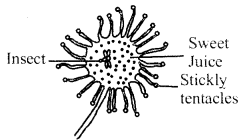
Question 5.
How do saprotrophs get nutrients? Give examples.
Answer:
Saprotrophs secrete digestive juices on the surface of dead and decaying matter. The digestive juices convert it into a solution which is absorbed by them to get nutrients. pab
Long Answer Type Questions
Question 1.
Classify nutrients on the basis of their amount required by plants.
Answer:
On the basis of amount of nutrients required by plants, nutrients can be classified as :
1. Macro nutrients
2. Micro nutrients
- Macro nutrients – These nutrients are required by plants in large amount. In plant tissues, t’ eir quantity is from 0.2% to 4%.
For example: carbon, hydrogen, nitrogen ‘xygen, etc. Macro nutrients are further divided into o types :
(a) Primary macro nutrients
(b) Secondary macro nutrients - Micro nutrients – These are the nutrients that are required in very low quantity by the plants. In plant tissues, their quantity is even less than 0.02% but they are important for the plants. Even their small amount affects the normal growth of plants.
For example: zinc, copper, iron, boron, etc.
Question 2.
Draw labelled internal structure of a leaf.
Answer:
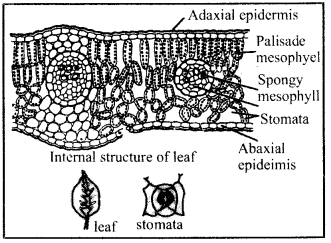
Question 3.
Explain the process of photosynthesis.
Answer:
The leaves of a plant have a green pigment called chlorophyll. It helps leaves capture the energy of the sunlight. This energy is used to prepare food. The cholorophyll containing cells of green plants make their own food in the presence of sunlight, water and carbon – dioxide. This process is called photosynthesis. This process is represented as :

In this process, food is prepared in the form of carbohydrate and oxygen is released. This carbohydrate gets converted into starch and is stored in the plant.
Question 4.
What are symbiotic plants? Explain briefly.
Answer:
Some organisms live together and share food, water, shelter and nutrients. This type of living is called symbiosis and such plants are called symbiotic plants. An example of symbiosis is lichen. Fungi and algae live together in lichens. Algae contains chlrophyll but fungi do not have Chlorophyll. Algae provides food to fungi and in return, fungus provides shelter and water to the algae.
We hope the RBSE Solutions for Class 6 Science Chapter 2 Nutrition in Plants will help you. If you have any query regarding Rajasthan Board RBSE Class 6 Science Chapter 2 Nutrition in Plants, drop a comment below and we will get back to you at the earliest.